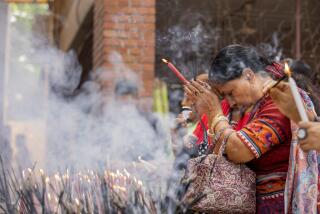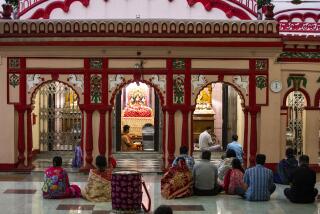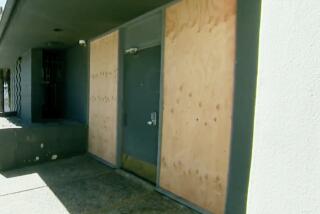Hindu Militants Raze Mosque, Stir India Crisis : Religion: Mob wants temple built on disputed Muslim site. Prime minister orders federal rule in state.
AYODHYA, India — Tens of thousands of frenzied, militant Hindus stormed and demolished a disputed 16th-Century mosque here Sunday, plunging India into a grave political crisis and threatening to renew nationwide communal bloodshed pitting Hindus against Muslims.
Prime Minister P. V. Narasimha Rao made an emotional appeal for calm in a rare national television address, calling the attack by radical right-wing Hindus on the Muslim shrine a “betrayal of the nation.” He ordered central government rule imposed in Uttar Pradesh, the country’s largest and most populous state, where the attack occurred.
But Rao’s embattled minority government came under immediate pressure to resign as jubilant fundamentalist Hindus, emboldened by their unexpected victory in the long-running religious and political conflict here, threatened to attack thousands of mosques across India. Security forces were put on alert around the country as tensions rose.
Previous clashes over Hindu demands to demolish the shabby, unused mosque and build a giant temple complex over it sparked anti-Muslim riots that left more than a thousand people dead and caused the downfall of national governments in 1989 and 1990. The volatile issue has polarized India as few others since independence and now presents a severe test for the future of secularism in the world’s largest democracy, where Hindus make up 83% of the population and Muslims 11%.
The seething mob here, part of a crowd of Hindu pilgrims and bearded holy men that police estimated at 200,000 to 300,000 people, easily overran a triple line of barbed-wire-topped barricades and broke through police cordons outside the mosque. The attackers used iron pickaxes, pikes and Hindu tridents to steadily smash the mosque’s three onion domes and brick platform, then threw grappling hooks and ropes to pull down police guard towers and floodlights.
Several thousand state police, most of them armed with only sticks and bamboo shields, fled in terror as rocks and bricks pelted their lines shortly before noon.
Reinforcements of paramilitary police, many openly sympathetic to the attackers, hid in side streets and courtyards as the wild mob rampaged all afternoon and into the evening through Ayodhya’s narrow streets, torching vehicles, Muslim homes and at least one more mosque.
Encouraged by their leaders, many in the crowd quickly turned on Indian and foreign journalists covering the melee. Several reporters, photographers and TV crews were pushed, hit with rocks and beaten in angry scuffles. A U.S. photographer was chased with a sword, a Swiss reporter fought off a man who tried to strangle him and a TV cameraman was pushed off a rooftop onto a tar pit. Several journalists had cameras, recording equipment and other gear smashed or stolen.
Peter Heinlein, the New Delhi correspondent for the Voice of America, was hit on the back of the head with an iron rod. Blood poured down his face and soaked his shirt as he staggered into a nearby temple. He was taken to a hospital three hours away in Lucknow and then flown to New Delhi. A Visnews cameraman was also beaten and bloodied, his TV gear destroyed.
The Los Angeles Times correspondent was beaten on the back with a bamboo staff and hit in the leg with a brick before being chased from the area by men with sticks. He and a dozen other journalists were trapped all afternoon in the nearby temple, and then a police post, after Hindus attacked their car with rocks, angrily pulled them out and refused to let them leave the city.
Initial reports said that four Hindus were killed and more than 100 were injured by falling stones and mortar as the mob surged through the barbed wire and began demolishing the mosque in a chanting, screaming fury. Several men could be seen falling from the plaster domes as crowds clambered on top.
Fundamentalist Hindus claim that the mosque, built in northern India during the reign of Babur, the first Muslim Mogul emperor, was erected over the birthplace of Lord Rama, a legendary Hindu demigod who figures large in religious mythology.
The claim has been the rallying cry of a stridently right-wing Hindu organization, the Vishwa Hindu Parishad. The hard-line group is allied with the increasingly powerful Bharatiya Janata Party, a once-obscure ultranationalist Hindu party that used the temple dispute to win control of four major states in 1990 elections and become the official political opposition in Parliament.
As Sunday’s showdown neared--the date and time were decreed auspicious by Hindu priests--government officials and moderate Hindu leaders publicly pleaded for calm and filed several court petitions in hopes of heading off a confrontation at what a Sunday Times of India headline called the “Temple of Doom.”
Uttar Pradesh state officials promised to protect the site, about 310 miles southeast of New Delhi. They instead announced a ceremony to allow organized bands of kar sevas, or holy workers, to wash and consecrate a concrete platform on government-owned land just in front of the barricaded mosque.
As the muggy morning wore on, half-naked holy men carrying silver tridents and wearing saffron robes chanted and prayed in the hot sun. One man shook his head wildly in meditation. Others joyfully danced, banged drums, clanged cymbals and shouted “Hail, Lord Rama!” over and over. The mood was festive.
But some warned of the violence to come. “The Muslims take our temple,” said Ayyapan Swami, a barefoot, bearded holy man who wore a button with the Hindu script for Om, his mantra, outside the mosque. “We will take it back. We will finish the mosque forever today!”
Nearby, Dwapak Kumarnukerjwe, a pudgy Hindu office worker, nodded his head happily. “We don’t agree to anybody’s court, to anybody’s law,” he said.
Then, shortly before the 12:12 p.m. ceremony was to start, the attack began. Groups of wild-eyed men with headbands first pushed past police. A shower of rocks clattered on tin-roofed buildings around the mosque. Within moments, a youth climbed atop one of the mosque domes.
He used an iron bar to smash a Muslim symbol on top and began slowly waving a huge saffron flag, the holiest of Hindu hues. A deafening roar rose from the crowd watching from the surrounding courtyard and streets and from atop nearby hills and rooftops.
The mood instantly turned ugly. As the police ran away, thousands of screaming Hindus swarmed forward to pull down barricades made of iron poles lashed to wooden posts. The poles then were used to pound the brick walls and chip away at the domes. A thick cloud of choking dust filled the air.
By nightfall, only rubble was left. All three domes were down, and the crowd’s mood turned celebratory again. Long lines of chanting men held bricks and chips of mortar triumphantly aloft as they snaked through the crowded alleys and streets and flooded roads leaving the city.
More to Read
Sign up for Essential California
The most important California stories and recommendations in your inbox every morning.
You may occasionally receive promotional content from the Los Angeles Times.











